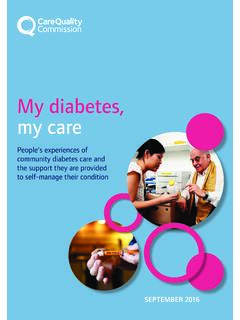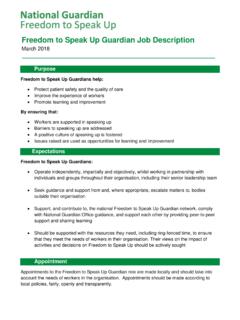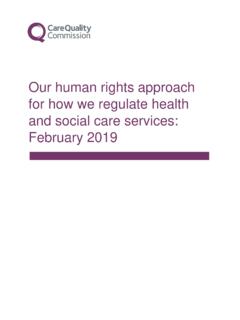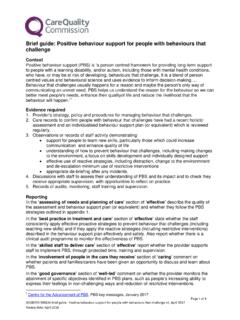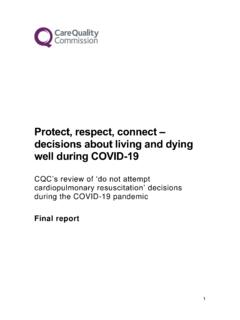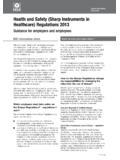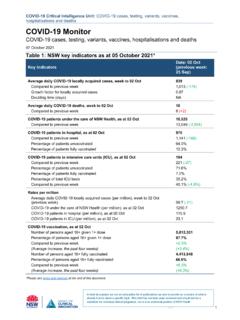Transcription of The state of health care and adult social care in England ...
1 The state of health care and adult social care in England 2020/21HC 753 care Quality CommissionThe state of health care and adult social care in England 2020/21 Presented to Parliament pursuant to section 83(4)(a) of the health and social care Act 2008. Ordered by the House of Commons to be printed on 21 October 2021. HC 753 Crown copyright 2021 This publication is licensed under the terms of the Open Government Licence except where otherwise stated. To view this licence, visit Where we have identified any third party copyright information you will need to obtain permission from the copyright holders publication is available at enquiries about this publication should be sent to us at ISBN 978-1-5286-2936-2E number E02681663 Printed on paper containing 75% recycled fibre content minimumPrinted in the UK by HH Associates Ltd.
2 On behalf of the Controller of Her Majesty s Stationery state of health care and adult social care in England 2020/21 Foreword 4 Evidence used in this report 71. People s experiences of care 92. Flexibility to respond to the pandemic 253. Ongoing quality concerns 524. Challenges for systems 63 Appendix: Ratings charts 76 References 884 The state of health care and adult social care in England 2020/21 ForewordLast year s state of care was written as the country fearfully anticipated a second wave of COVID-19 infections and deaths. This year, the success of the vaccination programme has given hope that the virus can be contained but alongside this hope is the recognition that COVID-19 will continue to cast a long shadow over all aspects of everyday life, in particular the health and care system.
3 The system has not collapsed but the system is composed of individuals, both those who deliver and receive care , and the toll taken on many of these individuals has been heavy. As we approach winter, the workforce who face the challenges ahead are exhausted and depleted, which has implications for the quality of care . They cannot work any harder they need support to work differently. The impact on people who use health and social care services has been damaging: the man whose lung cancer went undiagnosed; the teenage girl whose mental health support was paused; the boy with a learning disability whose mother, also his advocate, wasn t allowed to visit him; the woman who contracted COVID-19 in late pregnancy.
4 Many of the underlying problems are not new access to children and young people s mental health services, concerns about closed cultures in services for people with a learning disability or autistic people, and poorer experience and outcomes around childbirth for Black and minority ethic women are all issues that pre-date COVID. But as we flagged last year, COVID-19 has exacerbated inequalities and continues to do so, meaning that people who were less likely to receive good care before and during the pandemic are in many cases the same groups disproportionally impacted by COVID-19. People with a learning disability, for example, are significantly more at risk from COVID-19 but our review of community care for people with a learning disability found that their physical health , including how COVID-19 may present, was not always considered.
5 Our inspections of services for people with a learning disability or autistic people continue to find examples of care so poor that we need to take action to keep people safe. To help address the multiple challenges faced by the care system, the government has now made a welcome billion investment it must be used to enable new ways of working that recognise the interdependency of all care settings, not just to prop up siloed approaches and plug demand in acute care . The 500 million committed to support the adult social care workforce has never been needed more, with rising vacancy rates as social care providers struggle to attract and retain staff. Monthly data from information submitted to CQC by providers of residential care shows their staff vacancy rate increasing steadily from in April 2021 to in September 2021.
6 Some care homes whose attempts at recruitment have failed are now having to cancel their registration to provide nursing care , leaving residents looking for new homes in local areas that are already at, or close to, capacity. 5 The state of health care and adult social care in England 2020/21If the funding for social care is to have any impact, there must be a sharp focus on developing a clearly defined career pathway for social care staff linked to training and supported by consistent investment, higher overall levels of pay to increase the competitiveness of the market, and good terms and conditions to ensure employers can attract and retain the right people. The alternative is that the sector will continue to lose staff to the retail and hospitality industries.
7 This will lead to reduced capacity and choice, and poorer quality care for the people who rely on social care resulting in a ripple effect across the wider health and care system that risks becoming a tsunami of unmet need across all sectors, with increasing numbers of people unable to access care . Increased stability in social care is the key not only to unlocking improved access and quality of care for the people who use it, but to easing pressure on the NHS by reducing emergency attendances and delayed discharges. There is short-term funding currently in place to help discharge patients who are no longer in need of hospital care but who may still require care services this has improved patient flow and has made a crucial difference to the viability of some social care providers.
8 If this funding were to be committed to for a longer period, care providers could begin to make longer term investments in staffing and buildings to provide much-needed step-down care . They could also build more meaningful relationships with primary, secondary and community care services as well with third sector organisations and with carers, who have too often been the missing pieces of the jigsaw. In addition to a commitment to longer-term funding, there is a need for accelerated funding to be made available now to targeted areas that are particularly struggling with demand, in order to urgently increase capacity over winter. As the number of people seeking emergency care continues to rise, leading to unacceptable waiting times for ambulances and in emergency departments, measures that improve capacity and patient flow are urgently needed.
9 Close working between providers, commissioners and all other parts of the health and care system is essential to safely manage risk through the forthcoming winter. We have seen some trusts and ambulance services work together to manage attendances at emergency departments in order to ease ambulance handover delays an issue having significant impact on people s care and to free up ambulances and paramedics to go out and care for people in the community. And in primary care , some areas are creating patient access teams to triage, prioritise and assess requests for appointments, home visits and advice, bringing together paramedics, pharmacists, community nurses and third sector partners alongside GPs to ensure people get access to the right care quickly.
10 We have also heard from trusts about the ways in which they are seeking to address the backlog of people waiting for NHS treatment, from patient-initiated follow-up to virtual outpatient clinics. As waiting lists for investigation and treatment lengthen, ensuring that they are managed well, fairly and safely will be increasingly crucial closer collaboration with primary care services and third sector organisations will be vital to this. 6 The state of health care and adult social care in England 2020/21 Ultimately, however, new models for urgent and emergency care are needed in which people receive the care they need where and when they need it and are less likely to be inappropriately funnelled into emergency departments and where primary care services are able to focus on those with complex co-morbidities, rather than patients who could be better treated in other settings and by other allied health professionals, such as community pharmacists.

